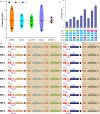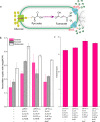Engineering the transmission efficiency of the noncyclic glyoxylate pathway for fumarate production in Escherichia coli
- PMID: 32760446
- PMCID: PMC7379832
- DOI: 10.1186/s13068-020-01771-3
Engineering the transmission efficiency of the noncyclic glyoxylate pathway for fumarate production in Escherichia coli
Abstract
Background: Fumarate is a multifunctional dicarboxylic acid in the tricarboxylic acid cycle, but microbial engineering for fumarate production is limited by the transmission efficiency of its biosynthetic pathway.
Results: Here, pathway engineering was used to construct the noncyclic glyoxylate pathway for fumarate production. To improve the transmission efficiency of intermediate metabolites, pathway optimization was conducted by fluctuating gene expression levels to identify potential bottlenecks and then remove them, resulting in a large increase in fumarate production from 8.7 to 16.2 g/L. To further enhance its transmission efficiency of targeted metabolites, transporter engineering was used by screening the C4-dicarboxylate transporters and then strengthening the capacity of fumarate export, leading to fumarate production up to 18.9 g/L. Finally, the engineered strain E. coli W3110△4-P(H)CAI(H)SC produced 22.4 g/L fumarate in a 5-L fed-batch bioreactor.
Conclusions: In this study, we offered rational metabolic engineering and flux optimization strategies for efficient production of fumarate. These strategies have great potential in developing efficient microbial cell factories for production of high-value added chemicals.
Keywords: Escherichia coli; Fumarate; Metabolic engineering; Pathway optimization; Transporter engineering.
© The Author(s) 2020.
Conflict of interest statement
Competing interestsThe authors declare that they have no competing interests.
Figures





References
LinkOut - more resources
Full Text Sources

